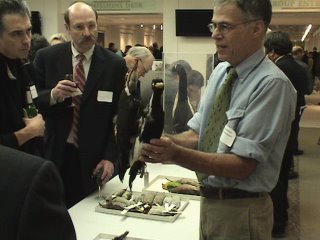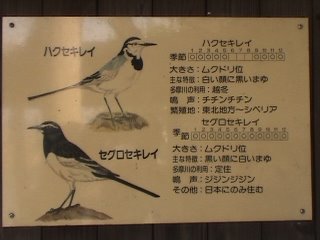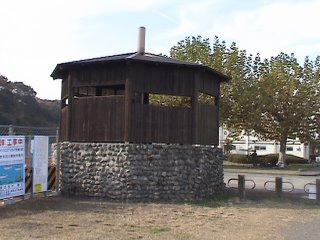The weather has been great in Chicago over the last few weeks, which has greatly assisted us in our Christmas Bird Count (CBC) scouting. The CBC that I have done for almost the last 10 years is the Lisle/Morton Arboretum CBC, which for many years has been sponsored by the Chicago Ornithological Society (COS). The compiler has divided the count circle into six different areas, with each area having essentially a team leader. Our merry little crew of insane birders has been tasked with birding Area 6 for the past couple of years; Area 6 includes a good chucnk of the forest preserves in the Palos area, a couple of old quarry lakes, the I&M Canal, the Des Plaines River, some marshes and sloughs, as well as some highly suburban areas. As the CBC season progresses, we'll keep you informed about some of the tricks we use to ensure a high species count.
Right now we're concerned with two environmental conditions that could greatly influence our species totals: abnormally high temperatures, combined with a long drought. Since most small bodies of water freeze up by the time of our count, we rely on flowing water (ie the Des Plaines River) and the deep quarry ponds to hold a few waterfowl species into December. In extremely cold seasons, almost all of the water in the circle freezes up, leaving the quarries and the Des Plaines River as the only areas with waterfowl. Last year, an extreme cold snap even froze the quarries and the river to a certain extent, but we still managed.
This year, the drought has completely dried up almost all of the smaller ponds, marshes, and sloughs. This means that many of our "duck spots" are bone dry, but as we lose waterfowl habitat, we gain sparrow habitat, and the edges of these sloughs have receded so much that they can be walked, for the first time in the 10 years or so that I have been birding in this area. And the warm temperatures mean that there are some great mud flats, and those mud flats are holding large numbers of Killdeer well into November. (It is extremely rare for a Killdeer to be in our count circle for the CBC, and I don't think we have ever had one in Area 6). However, these low water levels also mean that even a mild freeze will quickly freeze over any sloughs that still have water in them.
It is in this context that the BINAC core team (hey, only 9,990 birds to go!) went a-scouting last weekend, October 29, 2005. We had a modest 43 species, but our goal when scouting is not to maximize species counts or numbers, but to learn where the pockets of birds are hanging out.
Our first early-morning stop was at Bergman Slough, where the first bird I saw was a Northern Harrier. We started to walk the scrubby areas west of the slough, and stumbled upon a large (about 1500 birds) blackbird congregation, mainly Common Grackles, with a few Red-winged Blackbirds thrown in. We almost *never* get Common Grackle in Area 6 (or in rest of the circle, for that matter), so if these birds stick around, it would be quite the find. There was just a huge amount of activity in this scrubby area, an area which, in recent years, we have not always even covered on count day. There were tons of Blue Jays, at least 10 Eastern Bluebirds, along with White-crowned and Swamp Sparrows, Yellow-rumped Warblers, and a Golden-crowned Kinglet. The slough still had some water, and we found a Killder, plus Gadwall, Wood Ducks, Black Ducks, and Green-winged Teal. Probably the best bird of the day was a very elusive sparrow that we felt was likely a Vesper Sparrow. Hopefully this sparrow will stick around for a few more weeks.
We continued on to find a Rusty Blackbird, Red-headed Woodpecker, and more warblers and Blue Jays in a dried-up marsh near the Cap Sauers preserve. I must say that I expect Blue Jay numbers to be large this year, they seem to have really rebounded from a recent decline.
We walked the Will-Cook Road mudflats, and saw a few ducks, at least 15 Killdeer, and more Yellow-rumped Warblers.
The Mt. Vernon Cemetery was dead, so we headed to the John J. Duffy Preserve, where we found more Bluebirds and Grackles, along with a bunch of American Coots, more Gadwall, Woodies and GW Teal, with a couple of American Wigeon and Northern Shovelers thrown in for good measure.
After a quick lunch break, we headed out to a veeeeery long walk into uncharted territory along the Des Plaines River. We call this area "Goose Lake" because some old maps give this name to the largest pond that is in this area; the preserve as a whole really has no name, and is split between Cook and Will Counties. Nobody ever birds this area because it is hard to get to, no one knows where it is, and it is a long walk if you don't know a few short-cuts. We basically walk along the power line right-of-way; in some years when water levels are high, you have to cross an area between Goose Lake and the river that we call the "rocky point" and some winters the water level is about chest-deep, making the area beyond completely inaccessible. (Someone has recently cut a dirt road dwon from the bluffs into this area, just past the rocky point, possibly in preparation for the I-355 highway extenstion that is planend for this area.)
Anyway, to make a long story short, one of the Will County forest preserve gates was locked, so we ended up trying a new trail, getting lost, and retracing our steps for about a four-mile round trip. Our payoff for this was a decent selection of ducks, and more Rusty Blackbirds, but not much else.
After we split up, I checked the Worth Quarry, which is on the edge of Palos but not in the count circle. Nobody -- and I mean nobody -- checks this place, despite the fact that is has hosted some rarities in the past. I don't think it is even mentioned in any of the Chicago or Illinois birding guides, and I can count on one hand the number of birders who even know how to access this location. Anyway, there was a Mute Swan and a couple of Mallard there, along with an impressive total of 30 Killdeer. My count for the entire day was 49 Killdeer, which is an amazing number for Palos in late October. Warm weather + drought = late shorebird habitat.
My final stop was at Lake Katherine, where I viewed the semi-resident Trumpeter Swan, 6 Mute Swans, a couple of Coots, and not much else.
It was a long and full day of birding, and we learned a lot that will help us in our CBC scouting over the next few weeks. Who knows what the rest of November will bring...

 Tampa CBC) and, as always, there were a ton of birds, including 45 American Oystercatchers, and tons of other shorebirds.
Tampa CBC) and, as always, there were a ton of birds, including 45 American Oystercatchers, and tons of other shorebirds.





















 Apologies for the typos, but it has been a long day, maybe I'll fix them manually later. Might do a bit more birding tomorrow. Stay tuned.
Apologies for the typos, but it has been a long day, maybe I'll fix them manually later. Might do a bit more birding tomorrow. Stay tuned.


















